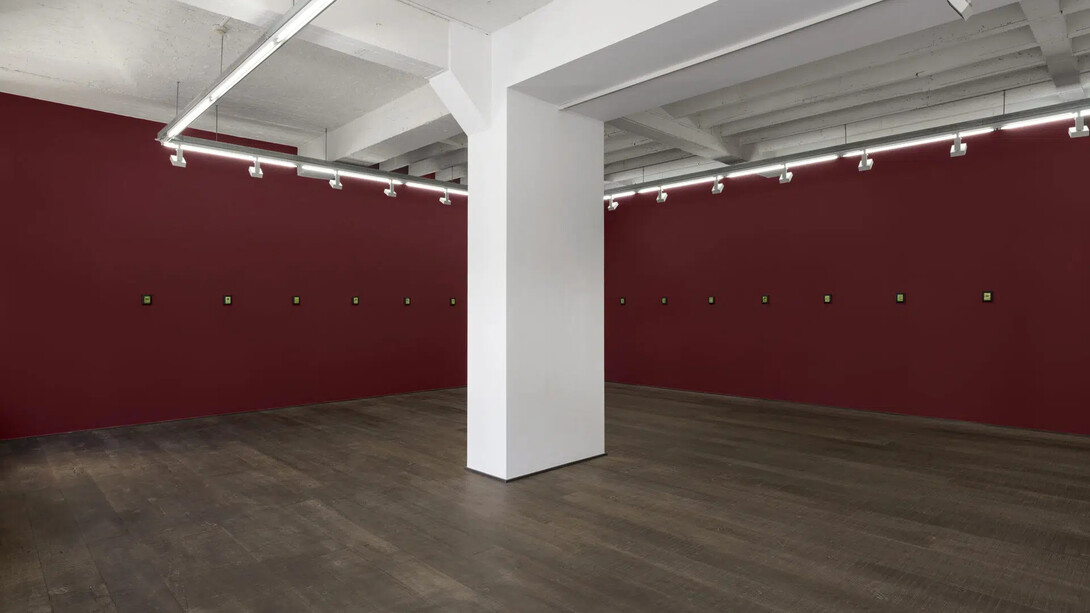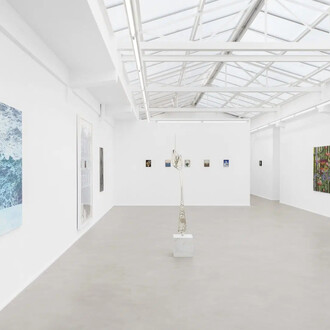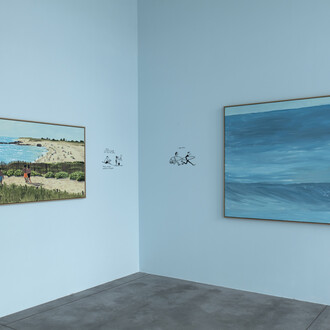Sanam Khatibi’s I miscalculated the stars imbues the gallery space with a misty stillness — the quiet pressure before the storm. The walls, punctured by almost miniature frames, invite the viewer to approach, look closely, and give each painting their full body and attention.
Khatibi’s work unfolds as a continuous production — a flow of ideas, forms, characters, and objects shaping her universe. Series are not actively planned; rather, they emerge, guided by a topic or subject. Here, we find small landscapes of trees floating in green, cloudy skies. Some compositions include a human figure — a woman, bare of all clothes. She prays, offers a sacrifice, sleeps, plays, falls from the tree, and more. With the air and, certainly, the size of medieval illuminations, these paintings give off a light, humorous, and at times naïve energy.
Khatibi’s humans are always naked. Far from intending an aspect of sexuality, desire, or lust, they are portrayed in what the artist calls “their most basic state.” To her, clothes are attributes of civilisation, while she seeks, on the contrary, our intrinsic nature — our animality, our ancient existence — untarnished by anything that might conceal it.
When painting I miscalculated the stars, Sanam’s hands listened to her gut more than her brain. Contrary to her general practice, where she deals with an extremely technical universe of symbols, acting on instinct allows her to free her animal and irrational side. The outcome is a new kind of alphabet, where each painting conveys a separate meaning depending on positioning, presence or absence, and the characteristics of each component. We have a background, a tree, a human figure (or not), producing an action (or not). The plainness of these elements allows endless projection and speculation, regardless of cultural perspective. Every painting was born of an intention — an amulet of sorts — each corresponding to a situation the artist was going through. As with the nudity, the symbolism of the tree — this surviving primordial shrine — but also the sacrifice and the idleness, all involve a ritualistic aspect: the action and reaction of humans within the universe. The most primitive part of our brain — the reptilian brain, or basal ganglia in scientific terms — governs our basic survival functions: aggression, dominance, territoriality, and, not least, ritual displays. To paint, Khatibi taps into precisely this part of her brain, choosing subjects that themselves arise from the same source.
Another key to deciphering these paintings lies in the spirited poetry of their titles: All you can eat, The sickle, Anything goes, You prefer the sky to me, Protection. Khatibi plays with words — their representation, their literal and metaphorical meanings — and matches them to the works. She puts no more conscious thought into the titles than into the paintings. The words come her way; she collects them until they are dispatched as names for a work or a series.
Her mix-and-match appears as a game — just as it belongs to us, the viewers, to perceive the paintings in ways that resonate with us most. This creative improvisation permeates the light-hearted energy that emanates from the compositions. Khatibi insists that her works remain playful, joyful, and, most importantly, never take themselves too seriously. Just look at those mischievous women walking on their hands and falling from trees.
Oops … I miscalculated the stars!
(Text by Gabriela Anco)
















